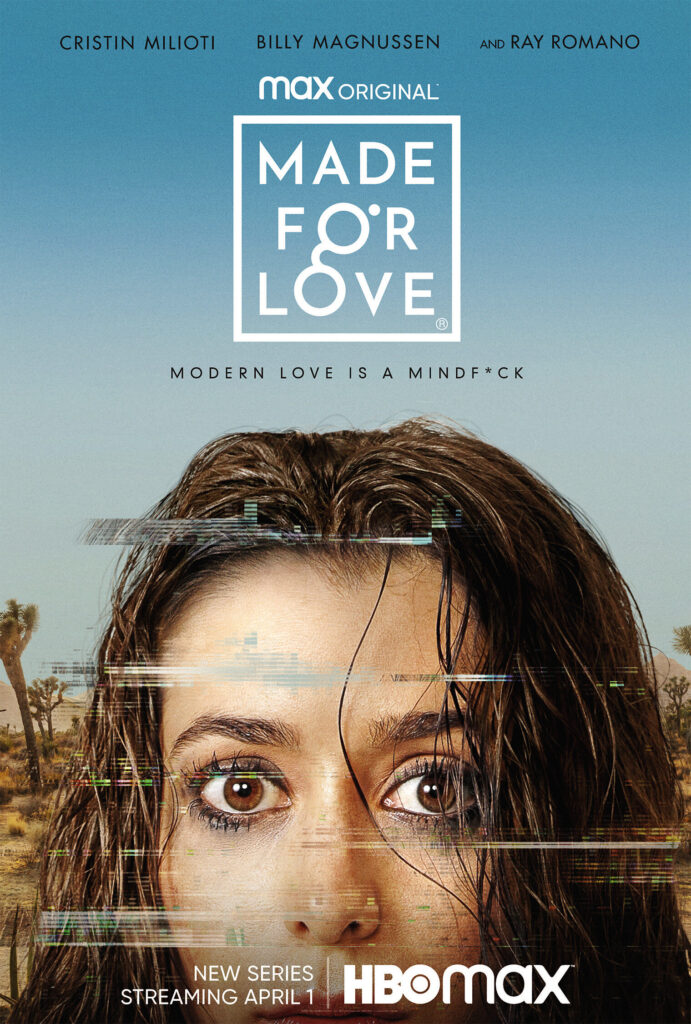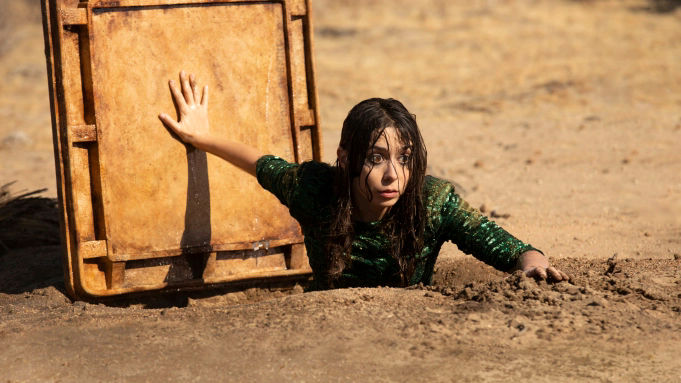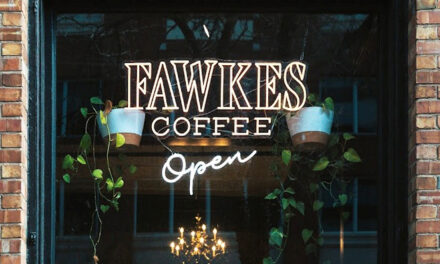Screens, Sex Dolls, and Social-Distancing: Made For Love is the Perfect Pandemic Binge
by Trista Peterson

“Love. It’s the centre of our lives– but our lives have changed.” Made For Love, an eight-episode series directed by Stephanie Laing (whose credits include the hit series and pandemic must-watch Veep) begins with this evocative line.
It’s delivered by Byron Gogol, CEO of a company called Gogoltech (to which Google’s resemblance is not subtle). He’s advertising his latest technological revolution – a tiny chip that, when implanted in the minds of two lovers, allows them to hear, see, think, and dream as one.
It’s just another among innovations that have made Byron (Tony-nominated Billy Magnussen) fabulously, extraordinarily, wealthy. So wealthy that he lives in a giant, completely secluded desert estate he calls “The Hub”– a home so advanced, so intuitive that it makes Ray Bradbury’s The Veldt look like a backwoods cabin.
Built from holographic cubes, The Hub can create an immersive virtual reality so close to the real thing that you might forget that it’s just that: virtual. We are introduced to a lush, tree-eclipsed rendering of The Hub that readily transforms into a white, sandy beach. The Hub is vibrant and beautiful, yet somehow less saturated than the outside world – a detail in the show’s engaging cinematography.
It might be impossible to distinguish The Hub’s virtual reality from the real world if only the people weren’t missing (and if not for the odd misplaced cube). This solitude is by design– overwhelmed and threatened by the unpredictability of the real world, Byron admits that he’s grown to fear life outside The Hub. He’s all alone, spare for a few devoted staff and the odd press visit. And, of course, Byron has his wife, Hazel (Cristin Milliotti, of whom I have been a fan since her time on How I Met Your Mother).
But Hazel turns out to be the one variable he can’t control, the one possession of his that can’t be optimized for his enjoyment. Not yet, anyway. And that’s why Hazel needs out.
Her chances of escape are slim, even as she makes her (dramatic) escape within the first few minutes of the series. Luckily (maybe ‘lucky’ isn’t quite the right word), Hazel teams up with her dysfunctional father, Herbert, whose portrayal by Ray Romano is hilarious despite its utter sadness. After losing his wife to cancer when Hazel was in middle-school, Herbert floats in and out of alcohol binges and has a (very) intimate relationship with his sex doll synthetic partner, Dianne– an example of the zany, larger-than-life quality of Made For Love that warrants the “comedy” tag on the show’s description.

I hit ‘play’ on Made For Love because I craved escapism (and because, to be honest, not much else caught my attention among my streaming services’ new releases) but got philosophy tailored to our current reality. And I didn’t hate it. I watched the entire four hours in one evening, about twice as long as I would normally spend watching TV on an evening with nothing else to do.
The star-studded cast’s acting was predictably good, the characters were complex (I found myself bouncing between contempt and pity for Byron; just pity for nearly everyone else), and the plot kept me hooked without being insufferably suspenseful. But what really made the show for me was its exploration of complex ideas through thick allegory, though it was a bit heavy-handed at times:
“I was you.” Hazel says to Dianne, whom Herbert has propped up in a dining chair for breakfast. “I was Byron’s doll.” Both women, plastic and flesh, are objects to their respective partners, facsimiles of the comfort of intimacy without the complexity of human emotion and desire. Clever, but I’m sure viewers would have picked up on Dianne and Hazel’s tragic similarities even if it hadn’t been stated so explicitly.
That aside, Made For Love perfectly captures my anxieties and fears in an undeniably Black Mirror-like way, but instead of heightening the stress of social media or automatronic police dogs, Made For Love exploited my pandemic-related stress. Trapped in a house, surrounded by screens? Check. Longing for freedom from a not-entirely uncomfortable, though boring, existence? I can relate. Social interactions limited to our spouses or roommates? Sounds familiar. Made For Love captures the current cultural zeitgeist so well that I was surprised to find out that the HBO Max series is actually based on a novel by Alissa Nutting (who helped create the show) released in 2017.
The novel’s TV adaptation couldn’t have come at a better time. Prior to our year of lockdowns and restrictions, I’m not sure I would have sympathized with Hazel’s desperation for escape from her perfectly-optimized life of virtual environments and existential boredom. But now, her disgust with the illusion of reality piped in by The Hub’s holographic architecture perfectly reflects the desire to throw my Macbook off the balcony that I experience at least once a day– and I’m one of the lucky ones who aren’t experiencing the invisible epidemic of domestic abuse exacerbated by the pandemic.
The show cleverly explores the shadow pandemic of violence against women exaggerated by our current work-from-home world by asking: how do we respond to abuse allegations that fall short of physical violence?
“He was so controlling, every day. He forced me to wake up at the same time. I had to eat a ton of vegetables. I could only play video games for a very specific amount of time,” Hazel tells a lawyer when he asks whether or not Byron abused her.
“Well that sounds like a goddamned Club Med spa,” he laughs. “Don’t tell my wife.”
Most naggingly, Hazel’s ordeal left me wondering: if I could replicate any vacation, any experience, any environment I could imagine, like The Hub can, would I? With just the flip of a switch my living room sofa might become a bench in a horse-drawn carriage ambling down the cobblestone streets of Paris or courtside seats to a Lakers game. Maybe a spot on the sand overlooking the Mediterranean Sea, my blankets replaced with warm sand. Reality– no matter how dull– could be subverted, elevated. Not such a bad thought in a world with no travel for the foreseeable future. Yet, I balk at the idea of reality reduced to holograph, a dynamic entity reduced to something that isn’t quite the real thing– something like Dianne.
This is the beauty of entertainment, isn’t it? Television has a way of tapping into our collective psychology, helping us process common experiences and enduring questions in a way that can be painful at times, relieving at others. It’s a Rorschach test for what scares us, what excites us. Made To Love showed me a world not so far off from our own, a world that undeniably scares me.
Aside from technologies like Alexa or Siri (to which I have a Luddite-like resistance to and mistrust of), proposals to build so-called “smart cities,” communities highly-optimized by real-time data collection are ongoing. Deep-faked political messages threaten public discourse and potentially democracy itself. Virtual reality headsets from Oculus, part of Facebook, invite us to “live the unbelievable.” Maybe The Hub is just the inevitable next step.
So, if you’re looking for a binge-watch, give Made For Love a chance. Decide for yourself whether the virtual reality on the horizon is a utopian bliss or an Orwellian nightmare.
Made For Love premiered April 1st and is available on Amazon Prime and HBO Max.


